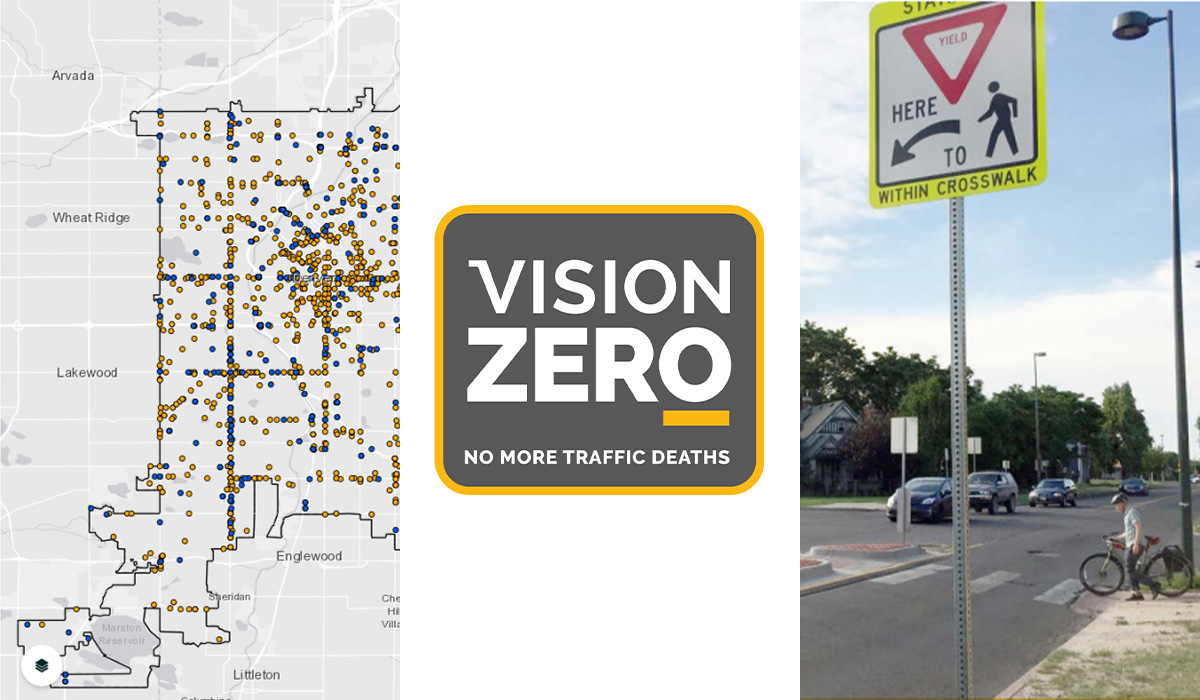Current State of Denver Roads
If you haven’t seen the signs or the persistent social media posts about Vision Zero, then you have definitely seen changing road shapes around the Denver Metro area. Extra bike lanes are going in, barriers between motor and bike lanes are building up, speed barriers are popping up, and speed limits are dropping. This is all part of Denver Public Work’s efforts to stamp out traffic collisions and deaths, bringing the later to “Zero.” According to the City and County of Denver, an auto collision has a 40% Chance of causing serious or fatal injury at 30 mph. That stat, however, skyrockets to 73% just by increasing the speed to 40 mph. In the Denver city limits, as of October 12, 63 people have died in collisions, and since 2016, 41% of those were due to speed. Fatalities have continued to increase every single year for the last nine years. Of the 63 fatalities so far this year, 2 were cyclists, 17 were pedestrians, 15 were motorcyclists, and 29 were vehicle occupants.
Denver Vision Zero has set a county-wide goal to have zero traffic deaths by 2030. Rather, though, than simply announce a lofty goal and simply flash stats on overhead announcement boards on the highways, the City and County of Denver have enacted an Action Plan to take proactive steps towards the goal. The first step involved analysis. Vision Zero members analyzed not only fatal collisions themselves looking for causes, but they also constructed a map of the areas within the county lines at which there were serious or fatal collisions over the last six years. You can find this map below or interact by clicking here. You can clearly note roads like Federal, Colfax, and 6th Avenue lighting up like a light-bright as hotbeds for major collisions. In fact, an ancillary map highlighting just the routes labeled High Injury Network zones (HIM), shows that while these roads account for only 5% of Denver streets, the account for 37% of fatal collisions and 40% of serious injuries. And county-wide, motor-vehicle collisions account for twice the number of deaths than homicide. In fact, traffic collisions are the #2 leading cause of hospitalizations in Denver County.
It is also interesting to note that Vision Zero identified that most collisions in these HIN routes are crashes happening near schools and in neighborhoods primarily comprised of lower income, disabled, and elderly citizens. In these areas, speed, aggressive driving, distracted driving, and impaired driving were the top causes of serious and fatal collisions.
What are the next steps in the Action Plan?
The five priorities within the action plan, laid out for the public here, are:
- Enhance City Processes and Collaboration
- Build Safe Streets for Everyone
- Create Safe Speeds
- Promote a Culture of Safety
- Improve Data and Be Transparent
How does this translate into increased safety and less traffic collisions?
To the city and county government, enhancing city processes and collaboration includes adding departments within local governments focused primarily on traffic safety, including studies, economic appropriation, and governmental reaction to tragedies. And the “building safe streets for everyone” phase is already visible in many neighborhoods. Vision Zero has already begun re-configuring streets and intersections to reduce speed, enhance bicycle and pedestrian detection, and improving light and visibility at crossings. A part of phase two is also significant enough to the effort for Vision Zero to make a separately delineated phase. Creating safer speeds city-wide has begun in several parts, with greater speed enforcement, lower speed limits in neighborhoods and school zones, and street design changes to create safer cycling and walking lanes and force lower speeds for vehicles though the use of barriers and speed bumps.
The next phase seems tricky, and it is the opinion of Queener Law that the city has failed already in some aspects of the promotion of a culture of safety. When e-bikes and scooters hit the streets of Denver, the city was behind the eight-ball with education and regulation. Since then, the city has tripped over itself, releasing multiple complicated ordinances for how these multi-modal measures should interact with other established traffic, and education of the community has failed in spade. Traffic collisions involving scooters and bikes have continued to rise. Vision Zero intends to correct those mistakes, and make better efforts to educate and make available alternate modes of travel outside of driving. It is the opinion of the Vision Zero team that multi-modal methods will not only reduce traffic, but they should also reduce traffic deaths, aggressive and impaired drivers from occupying the road, and give a broad range of safe methods of transportation to the HIN zones.
Finally, Vision Zero does not intend to rest on the current data and act accordingly. They are making a promise to the community to continue the analysis and make honest reports to the public of the successes, failures, or stagnation of their efforts. Many more details of the Action Plan are available here. And Queener Law occupies a position on the Mobility Council for the Downtown Denver Partnership, an organization that tasks itself with advising local leaders of what our community members are thinking and feeling about the government’s actions with regards to safety. Take a look at what the local government has planned for your neighborhood, and let us know your thoughts. Queener Law will take them back to the Partnership and push for the government to be advised. We will ensure the government hears us, and therefore hears you, about our collective safety. Traffic collisions are not an inevitability. How do you think we can prevent them?

